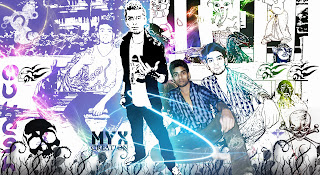Bboymyx.blogspot.com
People with high ego and unnecessary attitude deserves the standing ovation of the tallest finger... :p
June 05, 2014
May 05, 2014
May 04, 2014
January 28, 2014
January 27, 2014
January 23, 2014
January 20, 2014
January 17, 2014
January 11, 2014
mukesh artz
Art can connote a sense of trained ability or mastery of a medium. Art can also simply refer to the developed and efficient use of a language to convey meaning with immediacy and or depth. Art is an act of expressing feelings, thoughts, and observations.[28] There is an understanding that is reached with the material as a result of handling it, which facilitates one's thought processes. A common view is that the epithet "art", particular in its elevated sense, requires a certain level of creative expertise by the artist, whether this be a demonstration of technical ability, an originality in stylistic approach, or a combination of these two. Traditionally skill of execution was viewed as a quality inseparable from art and thus necessary for its success; for Leonardo da Vinci, art, neither more nor less than his other endeavors, was a manifestation of skill.Rembrandt's work, now praised for its ephemeral virtues, was most admired by his contemporaries for its virtuosity. At the turn of the 20th century, the adroit performances of John Singer Sargent were alternately admired and viewed with skepticism for their manual fluency, yet at nearly the same time the artist who would become the era's most recognized and peripatetic iconoclast, Pablo Picasso, was completing a traditional academic training at which he excelled.
A common contemporary criticism of some modern art occurs along the lines of objecting to the apparent lack of skill or ability required in the production of the artistic object. In conceptual art, Marcel Duchamp's "Fountain" is among the first examples of pieces wherein the artist used found objects ("ready-made") and exercised no traditionally recognised set of skills.Tracey Emin's My Bed, or Damien Hirst's The Physical Impossibility of Death in the Mind of Someone Living follow this example and also manipulate the mass media. Emin slept (and engaged in other activities) in her bed before placing the result in a gallery as work of art. Hirst came up with the conceptual design for the artwork but has left most of the eventual creation of many works to employed artisans. Hirst's celebrity is founded entirely on his ability to produce shocking concepts. The actual production in many conceptual and contemporary works of art is a matter of assembly of found objects. However there are many modernist and contemporary artists who continue to excel in the skills of drawing and painting and in creating hands-on works of art.
artz
Art is a diverse range of human activities and the products of those activities; this article focuses primarily on the visual arts, which includes the creation of images or objects in fields including painting, sculpture, printmaking, photography, and other visual media. Architecture is often included as one of the visual arts; however, like the decorative arts, it involves the creation of objects where the practical considerations of use are essential—in a way that they usually are not in a painting, for example. Music, theatre, film, dance, and other performing arts, as well as literature and other media such as interactive media, are included in a broader definition of art or the arts.[1] Until the 17th century, art referred to any skill or mastery and was not differentiated from crafts or sciences, but in modern usage the fine arts, where aesthetic considerations are paramount, are distinguished from acquired skills in general, such as the decorative or applied arts.
Art may be characterized in terms of mimesis (its reflection of life), expression, communication of emotion, or other qualities. During the Romantic period, art came to be seen as "a special faculty of the human mind to be classified with religion and science".[2] Though the definition of what constitutes art is disputed[3][4][5] and has changed over time, general descriptions mention an idea of imaginative or technical skill stemming fromhuman agency[6] and creation.[7]
January 08, 2014
January 06, 2014
December 31, 2013
December 28, 2013
November 24, 2013
Subscribe to:
Comments (Atom)
-
Creative
-
We are now ruled by Amma in South; (Jayalalitha) Didi in East;(Mamata Banerjee) Behenji in North; (Mayawati) Aunty in the Capital;(Sheila Di...





.jpg)

.jpg)
.jpg)
.jpg)
.jpg)
.jpg)
.jpg)
.jpg)
.jpg)






.jpg)
.jpg)


.jpg)
.jpg)
.jpg)
.jpg)
.jpg)
.jpg)
.jpg)
.jpg)
.jpg)
.jpg)
.jpg)
.jpg)
.jpg)
.jpg)
.jpg)
.jpg)
.jpg)
.jpg)













